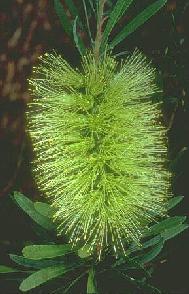AUSTRALIAN PLANTS

|
|
Callistemon pachyphyllus (reproduced with permission from the SGAP) |
The benefits of growing Australian Plants in Australia are well known and are usually categorised in relation only to the gardener who can enjoy a beautiful garden with the bonus of low maintenance, reduce water requirements, increased bird life.
But for me the attraction of native plants is a more of a philosophical one. Australian plants define the landscape with their distinctive blue-green and red-green colours, so different from the green-greens and yellow-greens of the European and North American forests. Even the smell of an Australian forest is special. Australian plants define the seasons for us in way appropriate to our temperate climate with a wattle season in August and a bottlebrush season in March, and other seasons indicated by the new red growth on the local eucalyptus species.
Australian plants integrate with the eco-system in a way introduced plants cannot, from the role they play in providing shelter for birds, mammals and reptiles, and the cooperative role between plant as food source and bird or insect as pollinator, to the symbiotic and parasitic relationships with other plants and the microscopic flora in the soil.
Resources
For the very best information on Australian Plants on the web check out The Society for Growing Australian Plants.See The Australian Flora Images and Links Page for a comprehensive list of links to Australian flora sites and a wonderful botanical tour of the Flinders Ranges.
More Australian garden links reside at Bob's Horticultural Connections.
The Grevillea Park at Bulli is really spectacular. The home page contains a list of open day dates.
My favourite book is "Australian Native Plants" by J. Wrigley and M. Fagg, (1979) ,Collins Publishers Australia. This book has information on more Australian Natives than you could poke a stick at but without being overwhelming.
Wild Lime by Juleigh Robins list many bush foods along with recipes and cultural notes for the plants. This fascinating book inspired me to compile this list of Bush Food Links and invent these recipes of my own.
Kuranga Nursery in Ringwood, Melbourne has a large beautiful, range of healthy plants and always has an inspiring display of currently flowering plants.
Austplant on Purves Rd, Main Ridge, on the Mornington Penninsula is a really lovely nursery.
Strange but true, I get hours of enjoyment reading the plain typed catalogue of ~3000 species that Nindethana Seeds publish. PO Box 2121, ALBANY, Western Australia, 6330
Projects
I maintain an ongoing project of raising natives from seed. I've had success raising paper daisy, Bracteantha bracteatum , and green wallum bottlebrush, Callistemon pachyphyllus and am now trying my hand at Anigozanthus flavidus and Banksia menziesii . The methods I've used were gleaned from the Society for Growing Australian Plants web site and have proved very useful.The seed was sown in sterile seed raising mix in ordinary nursery punnets that had been carefully cleaned.
These were placed in a capillary bed made from a polystyrene box from the green grocers, lined with plastic and half filled with river sand. A 10cm pot is placed in the corner, which is also half filled with sand. An old soft drink bottle filled with water is turned up side down in the pot. The punnets sit half buried in the sand and are watered from beneath by the capillary action fed by water from the soft drink bottle. The potting mix and sand have to be very moist for the capillary action to work. The soft drink bottle only needs to be replenished about once a week. My capillary bed sits outside, on a sheltered balcony
When the seedlings have their second leaves, I pot them on to 7.5cm pots. I prefer this size for small seedlings because it ensures consistent moisture around the roots. However, 7.5cm pots seem hard to come by so I have had to eat an awful lot of individual serve mousse and custard from the supermarket! The potting mix is sterilised by adding water to the mix and microwaving on HIGH for 7 minutes and allowing to cool. To extract the seedlings from the punnets I used a water bath method where the punnet is immersed in water and the seedlings allowed to float to the surface with no wrenching of the roots in removing them. The seedlings are held by their leaves in a pot half filled with potting mix, and the pot filled by gently adding mix around the roots. The pots are half buried in the capillary bed until ready to transplant.
Using these methods I have had excellent success, with no damping off and very little transplant shock.